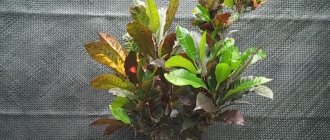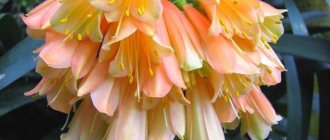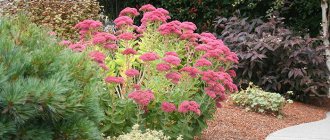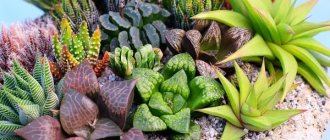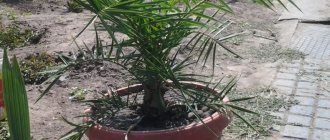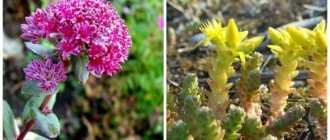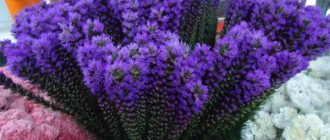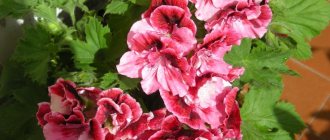Sedum is a close relative of the money tree. It is part of the large Crassulaceae family. The genus Sedum includes more than 500 species, which are subshrubs, herbaceous plants or succulents. Among the species there are annual and biennial flowers, as well as perennial flowers. In nature, sedum grows in the temperate climates of North America, Asia and Europe.
In floriculture, sedum succulents are mainly grown. Most sedums can be planted as hanging flowers, because in the wild they grow on stones and rocks, gracefully hanging from them. Sedum is a fairly common plant that does not require special care, but it is very easy for a novice gardener to get confused in the numerous types and varieties of plants, so it is worth studying their descriptions and photos in detail, which will help make a choice.
Choose the right type
Sedum (Sedum spp) will provide attractive texture with waxy foliage and graceful, vibrant flowers. Properly selected plants in combination with the container in which they will grow will complement the design of the room, be it a living room, kitchen or bathroom.
Many varieties of these indoor plants can be considered unpretentious in care. Growing at home does not require much effort, but you need to choose a variety suitable for cultivation in the chosen room and provide favorable conditions.
Bright and heat-loving varieties are the best choice for indoor growing. The plant will receive a sufficient amount of sunlight if it is placed next to a window. Six hours of light every day is the minimum required for normal growth. Normal growth is easy to notice: 2-2.5 cm of increase in length per month indicates favorable conditions.
Flower buds start out similar to broccoli heads, forming early but taking longer to develop than those of normal plants. The description of the flower is surprising in its diversity; the inflorescences have different shades, starting with pale tones, then becoming more saturated as they mature.
The flower heads are attractive from the buds until they dry out, and rarely produce seeds under indoor conditions.
What problems can there be when growing sedum?
Sedum Siebold
With excessive watering in cold conditions, the root system rots. If the plant shows signs of rot, these places should be cut off and the root should be treated with powdered charcoal. The leaf rosette may experience complete root rot. This requires a complete transplant.
Without urgent need, sedum does not need to be replanted often. Young plants require soil renewal once every 2 years, adults once every 4 years. Sedum tolerates the replanting process well at home. The pot should be wide and low for a shallow root system.
If leaves fall, then the first reason is not enough light, the second is damage. The leaves are very delicate and will fall off if touched carelessly.
The leaves begin to wrinkle and wither due to lack of moisture.
On the street and in the room
Versatile varieties grow outdoors and indoors. Beautiful tender Sedum plants that grow well indoors in winter and can be displayed outdoors in summer:
- compressed sedum (Sedum compressum), will bloom all winter,
- tree sedum (Sedum Dendroideum ssp. Praealtum), a small tree with strong green leaves,
- Morgana Cristata (Sedum Morganianum Cristata) with shoots divided at the ends,
- Sedum Nussbaumerianum creeping shoots with orange leaves.
In winter, care at home will not be burdensome, and as the weather warms up, these plants can be moved to the balcony or open street space.
Sedum (sedum) - varieties
The review includes those types of sedum that have spread throughout the world as houseplants.
- Morgan's sedum (Sedum morganianum) is one of the most popular indoor sedums. The shoots are creeping, up to 1 m in length, slightly curling. The leaves are smooth, drop-shaped, densely cover the shoots, and have a light green color. It usually blooms in summer with pink flowers collected in umbrella-shaped inflorescences of 8-12 pieces. Ideal for hanging compositions.
- Adolph's sedum (Sedum adolphii) is a bush with an erect stem, growing up to 50-60 cm in height, which begins to bend over time. The leaves are oval, pointed at the tips, fleshy, up to 4 cm in length. Initially, the leaves are green in color, but later turn yellow. It blooms with white flowers collected in hemispherical inflorescences.
- Siebold's sedum (Sedum sieboldii) - creeping, hanging shoots, up to 30-40 cm in length. The leaves are petiolate, round, leathery, green, and may have a red border along the edges. It begins to bloom closer to autumn with pink flowers.
- Thick-leaved sedum (Sedum pachyphyllum) – the stem is erect, branched, up to 30-40 cm in height. The leaves are cylindrical, bluish-green in color with reddish tips. It blooms in late spring, the color of the flowers is white or with a greenish tint.
- Linear sedum (Sedum lineare) - most often grown in open ground. Shoots creep along the ground. The leaves are arranged in whorls of several pieces, have a linear shape, are flat, and grayish-green in color. May bloom in spring and autumn. The flowers are yellow, collected in umbrellas.
- Compact sedum (Sedum compactum) is a dwarf succulent with ovoid, fleshy leaves tightly planted on the shoot. The color of the leaves is green with a bluish tinge. It blooms in summer with white fragrant flowers.
- Sedum (Sedum ewersii) - has lignified low-growing shoots, rounded fleshy leaves of a bluish tint. Flowers in July-August with pink corymbose inflorescences. Suitable for both garden and indoor growing.
- Sedum acre - shoots reach up to 10 cm in height and spread along the soil. The leaves are small, diamond-shaped. Blooms with bright yellow star-shaped flowers towards the end of summer. Most often grown in open ground.
- Multi-stemmed sedum (Sedum pluricaule) - grows into dense bushes with stems 6-10 cm in height. The leaves are bluish in color, ovate, dense, and turn red in the sun. Blooms in late summer.
- Forster's sedum (Sedum forsterianum) - shoots are slightly branched, 7-12 cm in height. The leaves are bright green, needle-shaped, and may turn pink in the sun. Can be grown indoors and outdoors. Blooms in summer.
Reproduction
Plants are propagated in two main ways:
- cuttings (vegetatively),
- seeds.
Vegetative propagation is the most common and gives quick results. Since the attachment to the leaf of these plants is rather unreliable and fragile, when manipulating the leaves the stem itself easily breaks off. In this case, you can do nothing with the fragment, just leave it in the air.
The plant's reserves will last for a long time, the leaves will remain alive for a long time until small roots appear. Then you can place the cutting in a flower pot without burying it deeply. With moderate humidity, the plant will continue to grow.
Propagation by seeds is the “aerobatics” of plant growers; it will require effort, but it will pay off with the rare species grown. Seeds are usually purchased from specialized online resources, where they will also tell you about cultivation.
General growing rules should be strictly followed:
- Before planting, mix the seeds with sand or talcum powder to ensure even distribution.
- Sow seeds directly onto prepared soil.
- You cannot cover the seeds with soil; they just need to be lightly pressed into the soil.
- Water either from below, from a tray, or spray a fine mist. Watering with water will simply wash away the seeds and the uniformity of seedlings will be disrupted.
- The seeds should not be allowed to dry out; during germination they should be kept moist, but not wet, and water should not completely cover them.
Happy life
The right growing conditions will make the difference between a plant that can tolerate indoor spaces and one that thrives, thrives, and flowers regularly. Basic conditions for indoor care: light, pot, soil and watering.
Possible problems
Growing sedum Burrito is simple, but if you deviate from the rules of agricultural technology, some problems may arise:
- mealybug;
- wilting of leaves;
- rotting of the roots and base of the stems;
- falling leaves after transplantation;
- stretching of internodes.
Plant attacks by mealybugs occur quite often. These hairy pests live in the axils of leaves. Insects are removed using a cosmetic stick, and the plant is treated with an insecticide.
The cause of leaf wilting is too dry soil. The crop is watered abundantly to restore the normal state of the soil.
Rotting of the roots and base of the stems occurs due to too wet soil and low temperatures.
Often after replanting, the leaves of the plant fall off. This manifestation is natural; it is necessary to give the plant time to recover.
When there is insufficient light, the internodes of the sedum tend to stretch. To prevent this process, it is enough to move the plant to a window facing south.
Pot and soil
A clay pot with drainage holes around the base is the best container for growing sedum. When replanting an adult plant, you need to take a pot 3-5 cm larger than the previous pot.
Sedum does not need rich soil, but it does need excellent drainage. For planting, choose soil with a “rich” composition or prepare it yourself. The prepared soil should consist of 2 parts potting soil, 2 parts river sand, 2 parts peat and 1 part baking powder - perlite or crushed charcoal.
Important: Sedum does not require fertilization. Their composition is difficult to select for uniform growth of a houseplant; fertilizers can change the shape of the leaves or stem.
If you still need to add fertilizer, it is best to choose a fertilizer with a slow release into the soil.
Outdoor care
Sedum Morgana is not suitable for growing in open ground, as it dies at low temperatures. Therefore, it is rarely used to decorate a garden or personal plot.
In the warm season, flowerpots and pots with sedum can be taken out to a brightly lit balcony, loggia or terrace, protected from sharp gusts of wind .
To decorate a flowerbed or alpine hill, it is better to take varieties that are more adapted to open ground conditions: Siebold sedum, lanceolate, spatulate-leaved, caustic sedum, Spanish, hybrid and others.
Watering
Proper watering is vital to maintaining the health of indoor sedums. The soil should be checked every day by testing the moisture content with your index finger at the depth of the roots. This is approximately 2-2.5 cm below surface level.
Water only if your finger is dry. Add water until the soil is saturated with moisture and excess liquid drains from the drainage holes.
How to water a flower in winter? At this time, water less frequently and allow the soil to dry completely. Sedum leaves will tell you when to water. If they begin to wrinkle slightly, it is time to water.
Description of the plant and cultivation history
Sedum has always attracted others with its interesting appearance. Its matte leaves are very juicy and creaky, which became the reason for the common names - hare cabbage and squeaky cabbage. In the old days, the most common sedum was with red flowers. Naturalists Pliny and Dioscorides described sedum as a medicine for healing wounds, for skin diseases and even for bone fractures. Traditional medicine today uses plant-based preparations to heal wounds of various types, including severe burns.
Most gardeners prefer to grow sedum as a hanging plant, because its shoots spread beautifully along the ground. The length of the flower can reach 2 m. The petiolate foliage has a round, slightly oblong shape with pointed edges and resembles water droplets. Species with ball-shaped and flat leaves are known. Flowering begins in May and lasts until October. The flowers are colored lilac, yellow, purple, white or pink.
In gardening, species that are resistant to cold are cultivated. There are many more varieties of indoor sedum, so everyone can choose the most suitable sedum for themselves.
Pests and diseases
The plant genus Sedum is a broad group of perennial species that are collectively hardy and easy to grow. They only get sick from excess moisture; the roots of plants can rot in such conditions.
Powdery mildew, aphids and weevils can sometimes attack plants. The best solution is to simply wash off these pests with water. Wash carefully; stems and leaves break easily.
Hardy plants, even without flowering, are worth growing because of the leaves, which come in different shades, as shown in the photo of Sedum varieties. Taking into account the wide range of species, you can always choose a suitable flower arrangement to decorate a room or space.
Caring for sedum at home: how to get rid of pests
Pests and diseases rarely attack plants of the sedum genus. Almost all domesticated species do not cause their owner much difficulty in caring for themselves.
The description of the ornamental sedum plant states that broad-leaved species, such as sedum, can be affected by the false caterpillars of true sawflies from the family Tenthredinidae in late June or early August.
As soon as pests have been detected, the plant should be treated with Aktelicom. You can also lure pests with cabbage or lettuce leaves placed nearby and destroy them.
Cold, damp weather can harm such types of sedum as:
- Ordinary.
- Prominent.
- Red dotted.
The leaves and stems of these species are affected by fungal infections and become covered with dark spots.
The following video shows an affected sedum and tells you what to do with it:
All shoots and leaves that are covered with fungus are cut off and burned.
What other pests can affect sedum:
Aphid
Trips
Weevil
Aphids are found on large-leaf sedums. Treating the plant with insecticides will help get rid of it. Unfortunately, there are no special preparations for Crassulaceae, but they can be treated with insecticides, which are used when irrigating blackcurrant bushes. This product will not damage the sedum and will not burn the surface of the sheets.
Damage to sedum by thrips, which was recently brought to Europe, is quite rare. This leads to bending of the stems.
When planting and caring for sedum flowers, you may encounter the following trouble - the shoots can be damaged by the weevil. It is also called the sulcata mower or the sulcate-winged elephant.
The adult feeds only at night, while the larvae damage roots around the clock. The fight against this parasite is to exterminate all adult individuals. To do this, you need to lay a white cloth or sheet of paper under the plant in the dark and shake off all the insects, shining a flashlight, and destroy them.
